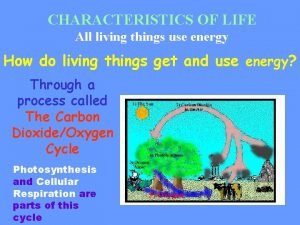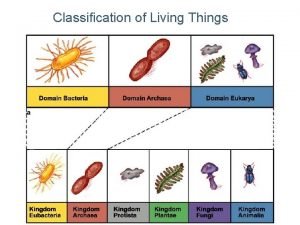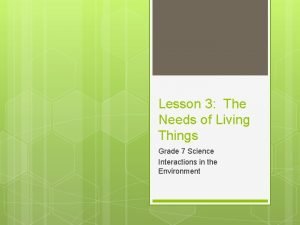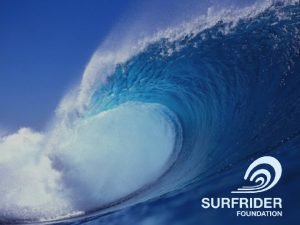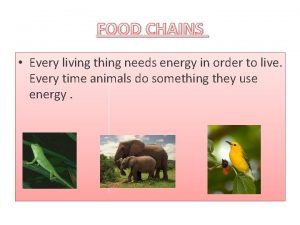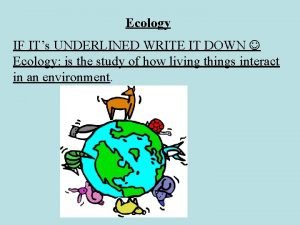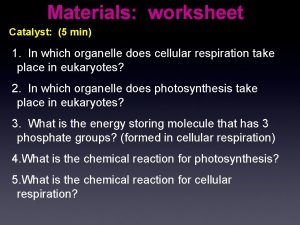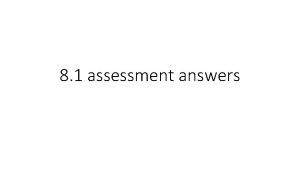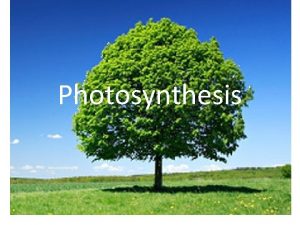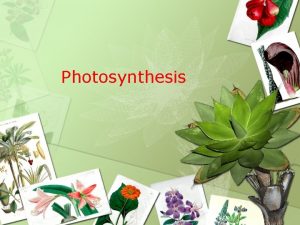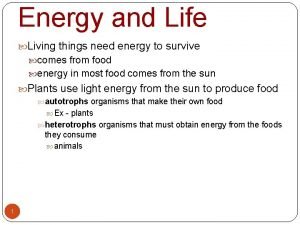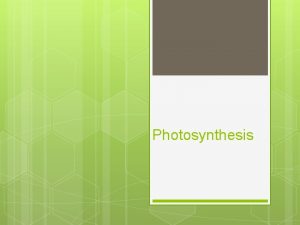Photosynthesis Energy and Life All living things need














- Slides: 14

Photosynthesis Energy and Life

All living things need energy n All energy on this planet starts with the sun

Autotrophs and Heterotrophs Autotrophs are organisms that can make their own food n Plants and some other organisms can make food from sunlight = photoautotroph n Some organisms make their own food chemically from rock or soil = chemoautotroph n

Autotrophs and Heterotrophs n Heterotrophs are organisms that must consume food to get energy n a. animals eat other organisms n b. some fungus feed off of dead organisms

Chemical energy in ATP (adenosine triphosphate) n ATP is the chemical fuel used to power all cell activities

Chemical energy in ATP (cont) n a. adenine – nitrogen containing compound n b. sugar – ribose n c. triphosphate – three phosphate groups (adenosine diphosphate has two phosphate groups)

n ATP and ADP can be converted back and forth as the need for energy fluctuates n if energy needs to be stored, ADP is converted to ATP by adding a phosphate group n if energy needs to be used, ATP is broken down to ADP because breaking off that last phosphate creates LOTS of energy

n n n ATP is the basic energy source for all cells ATP and Glucose n ATP is ideal for storing a small amount of readily available energy n Glucose contains 90 times as much energy as 1 ATP; better storage material Glucose is easily converted to ATP + other energy molecules

Photosynthesis: An Overview n In photosynthesis energy from sunlight is used to convert water and carbon dioxide into sugar

Investigating Photosynthesis n Van Helmont’s Experiment – determined that the mass of a plant comes mostly from water; “hydrate” part of carbohydrate (“carbo” part comes from carbon dioxide)

Investigating Photosynthesis n However, he didn’t realize that the carbon in the air (carbon dioxide) makes sugars & contributes to the mass of his tree.

Investigating Photosynthesis n Priestley’s experiment – discovered two things with his experiment: candles need something (oxygen) in the air to burn, and plants produce that something (oxygen) that candles need to burn

Investigating Photosynthesis n Jan Ingenhousz – revealed that Priestley’s experiment only worked in the presence of light n Summation of conclusions – when light is present; plants convert carbon dioxide and water into carbohydrates and oxygen

The photosynthesis equation n 6 CO 2 + 6 H 2 O light C 6 H 12 O 6 + 6 O 2 n Plants can “string” simple sugars together to make starches
 The smallest living unit within the human body is
The smallest living unit within the human body is Life processes
Life processes Life cycle of all living things
Life cycle of all living things Whats an energy pyramid
Whats an energy pyramid The 8 levels of classification
The 8 levels of classification Tissues group together to form
Tissues group together to form What are the 5 basic needs of all living things
What are the 5 basic needs of all living things Are all living things based on the metric system
Are all living things based on the metric system All living things 1955
All living things 1955 How many links are there in a food chain
How many links are there in a food chain Primary producers food web
Primary producers food web Gets its energy from eating living things
Gets its energy from eating living things How living things obtain energy worksheet answers
How living things obtain energy worksheet answers Explain how adp and atp are each like a battery
Explain how adp and atp are each like a battery Photosynthesis transforms light energy into chemical energy
Photosynthesis transforms light energy into chemical energy


